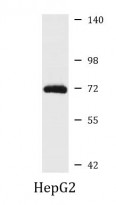ARG58953
anti-POLH / DNA Polymerase Eta antibody
anti-POLH / DNA Polymerase Eta antibody for ICC/IF,Western blot and Human,Mouse,Rat
Overview
| Product Description | Rabbit Polyclonal antibody recognizes POLH / DNA Polymerase Eta |
|---|---|
| Tested Reactivity | Hu, Ms, Rat |
| Tested Application | ICC/IF, WB |
| Host | Rabbit |
| Clonality | Polyclonal |
| Isotype | IgG |
| Target Name | POLH / DNA Polymerase Eta |
| Antigen Species | Human |
| Immunogen | Recombinant fusion protein corresponding to aa. 20-320 of Human POLH (NP_006493.1). |
| Conjugation | Un-conjugated |
| Alternate Names | Xeroderma pigmentosum variant type protein; RAD30; RAD30A; XP-V; DNA polymerase eta; EC 2.7.7.7; RAD30 homolog A; XPV |
Application Instructions
| Application Suggestion |
|
||||||
|---|---|---|---|---|---|---|---|
| Application Note | * The dilutions indicate recommended starting dilutions and the optimal dilutions or concentrations should be determined by the scientist. | ||||||
| Positive Control | HepG2 | ||||||
| Observed Size | 70 kDa |
Properties
| Form | Liquid |
|---|---|
| Purification | Affinity purified. |
| Buffer | PBS (pH 7.3), 0.02% Sodium azide and 50% Glycerol. |
| Preservative | 0.02% Sodium azide |
| Stabilizer | 50% Glycerol |
| Storage Instruction | For continuous use, store undiluted antibody at 2-8°C for up to a week. For long-term storage, aliquot and store at -20°C. Storage in frost free freezers is not recommended. Avoid repeated freeze/thaw cycles. Suggest spin the vial prior to opening. The antibody solution should be gently mixed before use. |
| Note | For laboratory research only, not for drug, diagnostic or other use. |
Bioinformation
| Database Links | |
|---|---|
| Gene Symbol | POLH |
| Gene Full Name | polymerase (DNA directed), eta |
| Background | This gene encodes a member of the Y family of specialized DNA polymerases. It copies undamaged DNA with a lower fidelity than other DNA-directed polymerases. However, it accurately replicates UV-damaged DNA; when thymine dimers are present, this polymerase inserts the complementary nucleotides in the newly synthesized DNA, thereby bypassing the lesion and suppressing the mutagenic effect of UV-induced DNA damage. This polymerase is thought to be involved in hypermutation during immunoglobulin class switch recombination. Mutations in this gene result in XPV, a variant type of xeroderma pigmentosum. Several transcript variants encoding different isoforms have been found for this gene. [provided by RefSeq, May 2014] |
| Function | DNA polymerase specifically involved in DNA repair. Plays an important role in translesion synthesis, where the normal high fidelity DNA polymerases cannot proceed and DNA synthesis stalls. Plays an important role in the repair of UV-induced pyrimidine dimers. Depending on the context, it inserts the correct base, but causes frequent base transitions and transversions. May play a role in hypermutation at immunoglobulin genes. Forms a Schiff base with 5'-deoxyribose phosphate at abasic sites, but does not have lyase activity. Targets POLI to replication foci. [UniProt] |
| Cellular Localization | Nucleus. [UniProt] |
| Calculated MW | 78 kDa |
| PTM | Monoubiquitinated by RCHY1/PIRH2; ubiquitination inhibits the ability of PolH to interact with PCNA and to bypass UV-induced lesions. [UniProt] |
Images (2) Click the Picture to Zoom In
-
ARG58953 anti-POLH / DNA Polymerase Eta antibody ICC/IF image
Immunofluorescence: U2OS cells stained with ARG58953 anti-POLH / DNA Polymerase Eta antibody.
-
ARG58953 anti-POLH / DNA Polymerase Eta antibody WB image
Western blot: 25 µg of HepG2 cell lysate stained with ARG58953 anti-POLH / DNA Polymerase Eta antibody at 1:1000 dilution.







